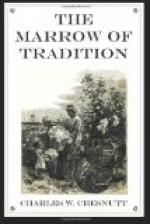This untimely accident of the rattle, a fatality for which no one could be held responsible, had confirmed the unlucky omen. Jane’s duties in the nursery did not permit her to visit her friend the conjure woman; but she did find time to go out in the back yard at dusk, and to dig up the charm which she had planted there. It had protected the child so far; but perhaps its potency had become exhausted. She picked up the bottle, shook it vigorously, and then laid it back, with the other side up. Refilling the hole, she made a cross over the top with the thumb of her left hand, and walked three times around it.
What this strange symbolism meant, or whence it derived its origin, Aunt Jane did not know. The cross was there, and the Trinity, though Jane was scarcely conscious of these, at this moment, as religious emblems. But she hoped, on general principles, that this performance would strengthen the charm and restore little Dodie’s luck. It certainly had its moral effect upon Jane’s own mind, for she was able to sleep better, and contrived to impress Mrs. Carteret with her own hopefulness.
V
A JOURNEY SOUTHWARD
As the south-bound train was leaving the station at Philadelphia, a gentleman took his seat in the single sleeping-car attached to the train, and proceeded to make himself comfortable. He hung up his hat and opened his newspaper, in which he remained absorbed for a quarter of an hour. When the train had left the city behind, he threw the paper aside, and looked around at the other occupants of the car. One of these, who had been on the car since it had left New York, rose from his seat upon perceiving the other’s glance, and came down the aisle.
“How do you do, Dr. Burns?” he said, stopping beside the seat of the Philadelphia passenger.
The gentleman looked up at the speaker with an air of surprise, which, after the first keen, incisive glance, gave place to an expression of cordial recognition.
“Why, it’s Miller!” he exclaimed, rising and giving the other his hand, “William Miller—Dr. Miller, of course. Sit down, Miller, and tell me all about yourself,—what you’re doing, where you’ve been, and where you’re going. I’m delighted to meet you, and to see you looking so well—and so prosperous.”
“I deserve no credit for either, sir,” returned the other, as he took the proffered seat, “for I inherited both health and prosperity. It is a fortunate chance that permits me to meet you.”
The two acquaintances, thus opportunely thrown together so that they might while away in conversation the tedium of their journey, represented very different and yet very similar types of manhood. A celebrated traveler, after many years spent in barbarous or savage lands, has said that among all varieties of mankind the similarities are vastly more important and fundamental than the differences. Looking at these two men with the American eye, the differences would perhaps be the more striking, or at least the more immediately apparent, for the first was white and the second black, or, more correctly speaking, brown; it was even a light brown, but both his swarthy complexion and his curly hair revealed what has been described in the laws of some of our states as a “visible admixture” of African blood.




